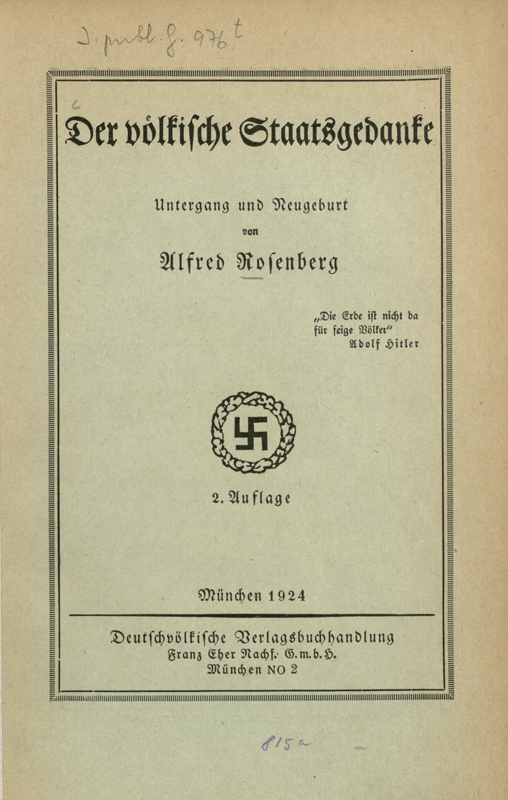Quellen
Hale, Oron J.: Presse in der Zwangsjacke, 1933-1945, Düsseldorf 1965.
Tavernaro, Thomas: Der Verlag Hitlers und der NSDAP. Die Franz Eher Nachfolger GmbH, Wien 2004.
Admission free
Parteiverlag der NSDAP

Publikation des Verlags Franz Eher Nachfolger | Alfred Rosenberg, Der völkische Staatsgedanke, München 1924 (BSB)
Am 17.12.1920 übernahm der Nationalsozialistische Deutsche Arbeiterverein den Verlag Franz Eher Nachfolger GmbH. Dessen damalige Hauptaufgabe war die Herausgabe des Völkischen Beobachters. Die Gelder für den Erwerb kamen aus einem Fonds der Reichwehr, über den der damalige Freikorpsführer Franz Ritter von Epp verfügte, von Dietrich Eckarts Vetter Simon, einem Geschäftsmann, von dem Augsburger Fabrikanten Gottfried Grandel und dem in Starnberg ansässigen Dentisten Friedrich Krohn. Dietrich Eckart bürgte mit seinem Vermögen. Am 4.8.1921 wurde Max Amann Leiter des Unternehmens, das zu dieser Zeit finanziell in Bedrängnis war. Um Abhilfe zu schaffen gliederte er 1923 eine Verlagsbuchhandlung an.
Anders als der Völkische Beobachter unterlag der Buchverlag nach dem gescheiterten Hitlerputsch vom 8./9.11.1923 keinem Verbot. Zum ‚Bestseller‘ entwickelte sich Hitlers zweibändiges Werk Mein Kampf (1925/27). Bis 1933 wurden insgesamt 241.000 Stück abgesetzt.
Amann baute seit 1933 den Eher Verlag zum größten Verlagskonzern Europas aus. 1933/34 nahm Hitler den Gauleitern die notleidenden Verlage ihrer Zeitungen aus den Händen und unterstellte sie Amanns Kontrolle. Die linke Presse wurde 1933 mit Gewaltmethoden zerstört, die katholische Presse seit 1935 zum Teil eingestellt, zum Teil dem Eher-Konzern einverleibt.
Viele nichtkonfessionelle Zeitungen wie die berühmte Frankfurter Zeitung sowie die großen Berliner Verlagsunternehmen von Ullstein und Mosse fielen ebenfalls dem Eher Verlag zur Beute. Im September 1937 waren 54 % der deutschen Zeitungen Eigentum des Parteiverlags oder von ihm abhängig.
In Bayern kontrollierte er neben den größten Zeitungen in München und Augsburg zahlreiche weitere über die entsprechenden Gauverlage. Am Vorabend des Krieges befanden sich fast nur noch Kleinstadtzeitungen in Privatbesitz. Im Februar 1943 eignete er sich mit der Hanseatischen Verlagsanstalt einen großen Zeitschriften- und Buchverlag an, zu dem auch Langen-Müller in München gehörte. 1944 kaufte Amann mit dem von Alfred Hugenberg gesteuerten Berliner Scherl-Konzern das letzte bedeutende private Zeitungsunternehmen.
Nach dem Zusammenbruch im Mai 1945 gingen die Vermögenswerte an den bayerischen Staat über, der aber von den Alliierten die Auflage erhielt, sie zu verkaufen. 1952 wurde der Verlag aus dem Handelsregister gelöscht.
Hale, Oron J.: Presse in der Zwangsjacke, 1933-1945, Düsseldorf 1965.
Tavernaro, Thomas: Der Verlag Hitlers und der NSDAP. Die Franz Eher Nachfolger GmbH, Wien 2004.